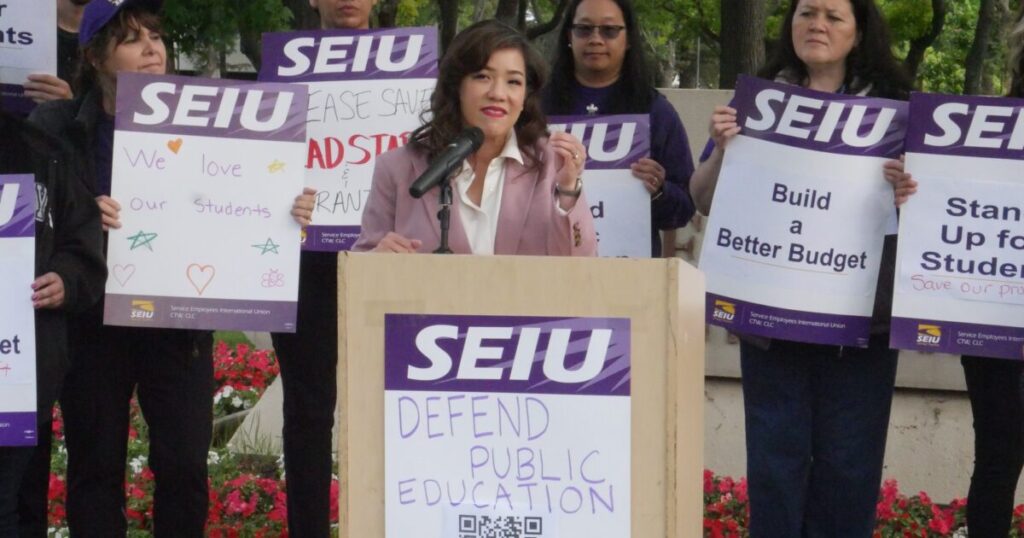A growing number of Silicon Valley residents – joined by state and federal lawmakers – are questioning the Santa Clara County Office of Education’s motives for decimating scores of programs and hundreds of teaching jobs serving the region’s most vulnerable children.
Teachers, labor leaders and county officials gathered outside the Office of Education Tuesday calling for the reversal of more than 250 educator layoffs affecting low-income preschoolers, migrants and special education students.
“Despite starting this fiscal year with $99 million in reserves, SCCOE announced arbitrary and capricious layoffs that will destroy essential and mandated services,” Sarah Gianocaro, the SEIU 521 Chapter President for SCCOE who represents special education teachers, said at the news conference.
The cuts were set into motion by a majority faction of the board of education – the same one that controversially voted to fire former superintendent Mary Ann Dewan last October. District executives under the board majority argued it was uncertain whether these programs, which relied on federal funding, would continue to receive it. Education officials pointed to proposals under the Trump Administration as the source of concern.
Yet state lawmakers have since slammed those same trustees for overspending on consultants, outside lawyers and insurance.
“SCCOE engaged in suspiciously high funding allocations – over $55 million more than what is typically spent in a year,” Gianocaro said at the news conference. “These DOGE-like cuts are arbitrary and capricious and will decimate our … public education system that ensures all students, especially the most vulnerable, can access critical services that impact their educational trajectory and ability to break the cycle of poverty.”
Joining her at the podium was Board of Education Trustee Tara Sreekrishnan — one of the few trustees to speak against the layoffs and criticize the board majority — as well as County Supervisor Betty Duong.
“What we need is even keeled leadership, thoughtful leadership that works with our workers — especially our frontline workers, to prioritize what’s important and have a shared plan moving forward,” Duong said at the news conference.
Board of Education President Maimona Afzal Berta and Superintendent David Toston’s office didn’t respond to requests for comment.
A bulk of the layoffs have hit the county’s federal Head Start program, after 169 educators – who prepare pre-school age children and toddlers in poverty for the K-12 system and connect families with social safety net resources – started receiving pink slips in March.
A letter from Congressman Ro Khanna last month called the 169 layoffs at the county’s federal Head Start program premature. He points out the federal budget hasn’t been finalized.
“I am told that local school districts have proposed to lay off Head Start staff due to the threat of these budget cuts. I also understand that the budget process has not reached its conclusion, and these funds may yet be saved,” Khanna wrote in an April 25 letter.
Office of Education leaders say federal funding for the program ends June 2025 pending renewal, with funding renewed on five-year cycles. Officials said they submitted a Head Start application for continued funding.
SCCOE officials say they face several converging financial pressures, including the expiration and reduction of multiple state and federal grants, declining student enrollment in Santa Clara County, rising operational costs and a flat general fund allocation from the state, unchanged since 2014.
Khanna said hope remains for Head Start. He pointed to the ongoing effort to secure state funding for the program in Sacramento. Assembly Bill 1428, introduced in February, would provide roughly $2 billion in funding per year for licensed childcare facilities including Head Start. More than 1,000 families — who would not be able to afford preschool in excess of $30,000 a year — benefit from Head Start programs, he wrote.
More than 1,000 families — who would not be able to afford preschool in excess of $30,000 a year — benefit from Head Start programs, he wrote.
“Adults who went through Head Start live healthier lives than those in their age cohort who did not have a Head Start education. These students are 7% less likely to be in poor health than their own siblings who did not participate in Head Start,” Khanna wrote.
Contact Brandon Pho at [email protected] or @brandonphooo on X.


